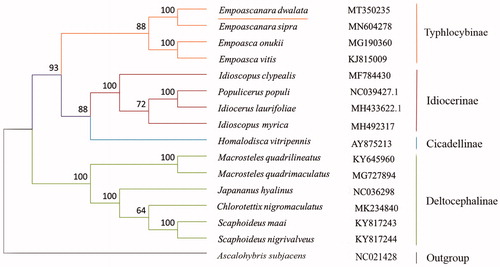Abstract
In this study, the complete mitochondrial genome of the leafhopper species Empoascanara dwalata (Hemiptera: Cicadellidae: Typhlocybinae) was sequenced and annotated, and the sequence is available in the GenBank with accession number: MT350235. The circular mitogenome with 15,271 bp in length, including 13 protein-coding genes (PCGs), 22 tRNA genes, two rRNA genes, and one AT-rich region. The nucleotide composition is as follows: A (41.7%), T (34.7%), G (10.6%), and C (13.0%). 11 PCGs have ATN as the start codon, except for atp8 and nad5 genes have TTG. The conventional termination codons (TAA or TAG) occur in 11 PCGs, while cox2 and nad5 use incomplete codon (T––) as termination codon. Phylogenetic analysis using 13 PCGs showed that E. dwalata was clustered with three other Typhlocybine species, which was consistent with the conventional classification.
At present, the subfamily Typhlocybinae has nearly 5000 species worldwide and is the second largest subfamily of Cicadellidae (Nielson and Knight Citation2000). The body size is quite small, usually between 2 and 4 mm, and distributed in all Zoogeographical regions. Empoascanara dwalata Dworakowska Citation1971 belongs to the tribe Erythroneurini with Empoascanara prima Distant, 1918 as its type species (Dworakowska Citation1971, Citation1980). Leafhoppers usually feed on trees and shrubs, and are harmful to woody and herbaceous plants through sucking, spawning, and virus transmission (Du et al. Citation2017). In this study, all the samples examined were collected from Maolan, Guizhou Province, China. The whole body was preserved in ethanol and deposited in the insect specimen room of Guizhou Normal University with an accession number GZNU-ELS-2019013. The total DNA is extracted from the entire body without the abdomen.
The circular mitochondrial genome of E. dwalata is 15,271 bp in size (GenBank no. MT350235), contains 37 typical mitochondrial genes (13 protein-coding genes, 22 tRNA genes, and two rRNA genes) and an AT-rich region. The gene order and orientation of E. dwalata were identical to other Hemiptera species. The basic component values of the whole mitogenome are highly A + T biased (A: 41.7%; T: 34.7%, G: 10.6%, C: 13.0%), the total A + T content is 76.4%, AT-skew and GC-skew it is 0.091 and −0.100 respectively. 23 genes were oriented on the majority strand (N-strand), whereas the others were transcribed on the minority strand (J-strand). The mitogenome of the leafhopper species E. dwalata has a total of 23 bp intergenic space, which is made up of 7 regions in the range from 1 to 23 bp. The largest intergenic spacer sequence of 9 bp is located between trnQ and trnM. 12 genes were found to overlap, with a total length of 37 bp, and the longest 8 bp overlap between trnW and trnC. All 13 PCGs have ATN as the start codon, except that atp8 and nad5 genes have TTG. Conventional stop codons (TAA or TAG) appear in 11 PCGs, while cox2 and nad5 use incomplete codons (a single T––) as stop codon. All tRNA genes are identified by ARWEN version 1.2 software. The rrnL gene is 1184 bp in size and is located between tRNL2 and tRNV. The rrnS gene is 729 bp in length and is located after tRNV.
The nucleotides sequences of 13 PCGs of E. dwalata and 15 reference sequences from other species in family Cicadellidae were used to construct phylogenetic relationship (). Maximum-Likelihood (ML) method was used through MEGA 6.06, which constructed with the IQ-TREE using an ultrafast bootstrap approximation approach with 10,000 replicates (Nguyen et al. Citation2015). The result showed that E. dwalata and other three species of subfamily Typhlocybinae were clustered into one clade, which was separated from other subfamilies, and consistent with the conventional classification. Therefore, the molecular data obtained in this study will facilitate future studies on the identification, population genetics, and evolution of the subfamily Typhlocybinae.
Disclosure statement
No potential conflict of interest was reported by the author(s).
Data availability statement
The authors confirm that the data supporting the results of this study can be obtained from the corresponding author, upon reasonable request, or openly available in NCBI GenBank database at https://www.ncbi.nlm.nih.gov with the accession number is MT350235.
Additional information
Funding
References
- Du YM, Dai W, Dietrich CH. 2017. Mitochondrial genomic variation and phylogenetic relationships of three groups in the genus Scaphoideus (Hemiptera: Cicadellidae: Deltocephalinae). Sci Rep. 7(1):1–10.
- Dworakowska I. 1971. On some genera of Erythroneurini (Cicadellidae, Typhlocybinae) from the oriental region. Bulletin de l’Academie Polonaise des. Sciences (Serie Des Sciences Biologiques). 19(5):341–350.
- Dworakowska I. 1980. On some species of the genus Empoascanara Dist. (Homoptera, Auchenorrhyncha, Cicadellidae, Typhlocybinae). Reichenbachia. 18(26):173–188.
- Nguyen LT, Schmidt HA, Von HA, Minh BQ. 2015. IQ-TREE: a fast and effective stochastic algorithm for estimating maximum-likelihood phylogenies. Mol Biol Evol. 32 (1):268–274.
- Nielson MW, Knight WJ. 2000. Distributional patterns and possible origin of leafhoppers (Homoptera, Cicadellidae). Rev Bras Zool. 17(1):81–156.

